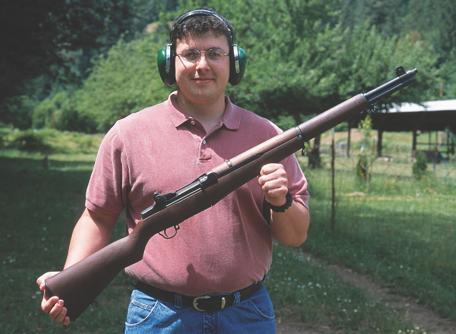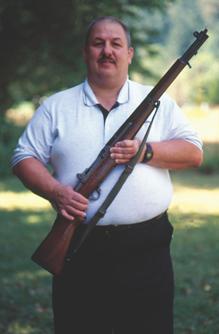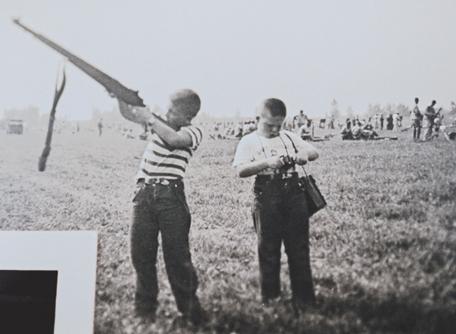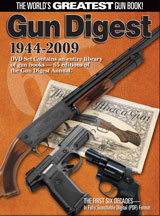 The author's son Jake enjoys shooting his father's and grandfather's DCM M-1s and will eventually inherit them. |
During the National Matches, the CMP sponsors a Small Arms Firing School, a program that has been in place since shortly after WWII. Rifles and ammunition are supplied and the shooting instruction is absolutely top-notch. I highly recommend that anyone interested in rifle shooting attend this school, particularly teenagers and young adults. It can quite literally change your life — it did for me when I went through it back in 1960.
The CMP also conducts many other junior and senior marksmanship programs, including programs in conjunction with 4-H clubs, the Boy Scouts, ROTC, college shooting tea?s, and a wide variety of other clubs and associations. They also sponsor an extensive youth air rifle competition program. In the past, they made lightweight low-recoiling M-1 Carbines available to clubs for junior-level centerfire rifle training, and may do so again in the near future. They also sell surplus ammunition, as well as a variety of M-1 Garand and other rifle parts to clubs and individuals at quite reasonable prices.
 The author in younger days holding his late father's National Match M-1 rifle bought in 1960 at Camp Perry from the DCM. |
It is notable that the guns my dad purchased from the DCM are among my first memories of firearms of any kind. As I said earlier, my father purchased his first guns from the DCM in the early 1930s: an M-1917 Enfield rifle and an M-1917 Colt revolver, both veterans of WWI. I once asked him why he purchased a Colt M-1917 rather than the also-available S&W M-1917. He told me the latter cost a few dollars more and that, since money was in such short supply during the Great Depression, he simply bought the cheapest one.
My father was working in California when the Japanese attacked Pearl Harbor. He told me that shortly after the attack it was impossible to find any firearms or ammunition for sale because everybody was arming themselves against a possible Japanese invasion of the West Coast. He recalled being very glad that he was already well armed, by the standards of the day, with his DCM M-1917 rifle and M-1917 Colt revolver. It was learned after the war that the Japanese were aware of the large numbers of well-armed American civilians, like my father, which contributed to discouraging any invasion plans. Yet again the CMP's mission was vindicated.
My dad's DCM M-1917 Colt was his primary utility and home defense handgun for most of his life, in spite of his subsequent acquisition of many more handguns. That old Colt was the gun he always used to dispatch sick or injured animals, as well as farm animals that were being butchered. It was the gun he grabbed to investigate things that went bump in the night. When, in his final years, he finally gave me the old beast, it had been kept loaded almost continuously for about fifty years. In honor of my late father, I still keep it loaded with modern high-performance hollowpoints; it now resides in a locked cabinet and has been loaded for over 70 years.
I was with my dad when he bought his National Match M-1 from the DCM in 1960 while he attended the National Matches at Camp Perry. As a teenager I usually competed with a surplus M-1903 Springfield because that was all that I could afford with my paper route income. Later, as my shooting improved, he often loaned me that superbly accurate M-1 to shoot in our club matches. That National Match M-1 is now one of my most prized possessions and I still break it out on occasion for a local rifle match.
As a youngster I was active in our local DCM-affiliated shooting club's youth program. We shot DCM-supplied Remington 513T 22 target rifles in the basement of the local YMCA. Thanks to good instruction, good equipment, and plentiful ammunition, I became a reasonably good small-bore rifle shooter.
At the unusually young age of 13 I attended the DCM's Small Arms Firing School at Camp Perry, along with two of my cousins and my late uncle Joe Karwan, while my late father was shooting in matches. There was no particular minimum age requirement to attend the school as long as you were big and strong enough to properly handle a 10-pound M-1 Garand rifle. Since I was already just under six feet tall, and nearly 200 pounds at 13, I qualified easily.
My uncle, who was in the Army in Hawaii when the Japanese attacked Pearl Harbor, and later served in Europe as a Combat Engineer from D-Day until the end of the war, was along mostly just to ride herd on the youngsters. He knew how to shoot an M-1 rifle very well already. He told us that when he was an NCO, which was for most of the war, even though he could have carried an M-1 Carbine or a submachine gun as his personal weapon, he always chose to carry an M-1 Garand because it was so reliable and effective.
 For more information about the Civilian Marksmanship Program (CMP), Click Here For more information about the Civilian Marksmanship Program (CMP), Click Here |
It was quite a heady experience for me and my cousins to have a brand new National Match M-1 Garand issued to us for the duration of the Small Arms Firing School, and any matches we wanted to enter. We were told to keep our M-1s clean and to keep the bolt locked back at all times, except when actually shooting. Indeed, if any competitor was caught off the firing line with his rifle bolt forward he would — at a minimum — get severely scolded. While we were there, one match competitor was caught in a common area with his M-1's bolt forward with rounds in the magazine; why, no one can say. He was unceremoniously packed up and escorted off the Camp Perry installation with instructions never to return.
Not only were we supplied with match-grade rifles at no cost, high-quality National Match 30-06 ammunition was even supplied – free! It was issued to us right on the firing line. We all had a great time, learned a lot about rifle shooting, and enjoyed the experience tremendously, including my Uncle who acquitted himself very well with an old and dear friend, the M-1 Garand. When we finally left Camp Perry, I could not afford to buy the National Match M-1 I had been issued, but I sure wanted to! My father bought his, though.
At the Small Arms Firing School we were instructed and coached by members of the various armed services teams, some of whom were national champions and record-holders. There is no doubt that my positive experience there with those outstanding military NCOs and officers was instrumental in my choosing to go to West Point a few years later. As an infantry officer in Vietnam, and later a Special Forces officer, the knowledge and skills in marksmanship acquired at Camp Perry and through other DCM programs were extremely useful to me and to the troops I commanded and worked with.
There are many examples. When I was an upper-class cadet at West Point I was detailed to help train underclassmen on shooting the M-14, and then get them “qualified,” The instruction I received from the CMP helped me immensely. Indeed, when any cadet failed to qualify, that knowledge allowed me to identify the problem with his rifle or technique and, with my help, most qualified the second time around. The same held true later as a junior officer in the Army. My CMP-acquired knowledge was passed on to others and employed to help my troops on numerous occasions.
My experiences in the CMP were also of tremendous value when I served in Vietnam. When I took over my rifle platoon in the 1st Cavalry Division, their idea of cleaning an M-16 was to fire a few tracers through it! Fortunately I?knew better and soon had my platoon cleaning, maintaining, and zeroing their M-16 rifles properly. My background in precision marksmanship in the CMP also helped me a great deal in supporting and using snipers effectively and made me a strong proponent of the use of precision marksmanship in combat. Even though I was an officer and usually occupied with commanding my unit, for about half my tour I carried an accurized M-14 or an XM21 sniper rifle as my personal weapon.
After Vietnam I served in both the 10th and 5th Special Forces Groups. At that time (mid-'70s) the Army had no active sniper program, and Special Forces never did have one. I took a shot at changing that and made a presentation to some staff members at the Special Warfare Center at Ft. Bragg, advocating the issuance of an M21 sniper rifle to each Special Forces A Detachment. I used my personal Springfield Armory M-1A (M-14 type) match rifle that I used for service rifle competition and fitted it with a borrowed ART sniper scope and mount to simulate an M21 sniper rifle for the presentation since there was not a single M21 on Ft. Bragg at the time.
 The author, circa 1955, trying to hold up his late father's M-1 while his younger brother Rick fiddles with his Kodak Brownie. In the background is part of Camp Perry's huge firing line. |
In the presentation I outlined the many capabilities of the M21 sniper rifle and emphasized the effectiveness it offered a Special Forces detachment, especially with regard to economy of force and cost-effectiveness. There is no question in my mind that, without my CMP training and experiences, I could never have made that presentation. Evidently I was convincing because, after my proposal was run up the flag pole, it was adopted and, ever since, every Special Forces Detachment Alpha (A-team) has been issued a sniper rifle.
Not only that but General Emerson, the 18th Airborne Corps Commander at Ft. Bragg at the time, liked the idea so much he initiated a sniper program for his major units (the 82nd and 101st Airborne Divisions) as well. The history books credit General Emerson with reviving the Army's sniper program after it was dropped after Vietnam, but it was lowly Captain Karwan in the 5th Special Forces that actually started that revival.
My experience with the CMP deserves a lot of the credit as well. One of my buddies who knows the above story insists on calling me “The Father of U.S. Special Forces Sniping.” I don't know about that, but I admit I am proud of the fact that today both the U.S. Special Forces and regular Army have an ongoing permanent sniper program and I had a significant role in making it happen.
While I have been out of the Army for a long time, there are still many soldiers out there that have had the benefit of the CMP to help prepare them for combat service. Just recently an Army unit that was about to deploy to Iraq was issued optically-sighted M-14 rifles for use as Squad Designated Marksman (SDM) rifles. An SDM is a sort of low-level sniper that is under the control of the rifle platoon leader and supports that unit with precision rifle fire, particularly at distances beyond the capability of a normal rifleman.
The problem was that nobody in the unit knew very much about the M-14 rifle or its capabilities in the SDM role. As a consequence, they turned to the CMP-affiliated Texas Rifle and Pistol Association which supplied some top-level civilian marksmen highly familiar with the M-14 to provide the necessary training on these rifles before the unit deployed. Yet again, the CMP accomplished precisely the mission it was originally developed for. I was just old enough in the '60s to get in on the tail-end of the period where the DCM was able to sell surplus guns to NRA members without much hassle, and at really low prices. During that period, my father and I both purchased M-1911 45-caliber pistols and M-1 Carbines from the DCM. One of my cousins and I also purchased M-1903A3 30-06 rifles. As I recall the price of each of the above, with packing and shipping, was right around $20 apiece. Yes, those were the days!
My father's DCM-purchased M-1911 was a pretty tired specimen, having been through both world wars and many rebuilds. He gave it to one of his brothers who sadly subsequently lost it. Mine was nearly as tired but it was still a decent shooter.
I was not able to get an M-1 Garand from the DCM until several years later when the DCM got permission to reopen M-1 sales under much more stringent requirements (proof of recent rifle competition and an FBI finger print check). At the time I was an Army Captain in Special Forces with a Top Secret security clearance, but I still had to go through all those hassles to buy my DCM M-1. John Larsen, a good friend who was one of the NCOs in my unit, and I shot in qualification matches and ordered our M-1s at the same time. John promptly got his while my order was refused because the DCM records indicated I had already purchased an M-1 in 1960. I pointed out that they had confused me with my father and that I would have been only 13 years old that year. The DCM eventually sent me my M-1, but not until I received a lot of kidding from John that the DCM obviously gave priority to NCOs because they were more important than officers.
The M-1 Garand that I received was typical of most service-grade M-1 rifles purchased from the DCM then, or the CMP today. It was used but not abused and had been totally rebuilt at least once in its history. It has an H&R receiver, but virtually all of its other parts — including its 1963-dated barrel — were made at Springfield Armory. Since it has a nice bore, it shoots quite well and I have used it in a John C. Garand match and other competitions.
As you can see, between my late father's DCM purchases and my own I have quite a nice little collection of DCM guns including a Colt M-1917 revolver, a Colt M-1911, an Eddystone M-1917, a Remington M-1903A3, a Winchester and an Inland M-1 Carbine, an H&R M-1 Garand and a Springfield National Match M-1 Garand.
Thinking back, I have fired every one of them in one kind of a match or another — except for one of the M-1 Carbines, and the handguns. I have had many enjoyable hours shooting all of them at targets and, on a several occasions, hunting with some of them. The old Eddystone M-1917 was shot one day from the bench at 100 yards with some particularly accurate match loads and repeatedly produced sub-MOA groups using its original peep sight. That's not too shabby for a WWI-vintage service rifle that cost $7.50! I hope the CMP stays alive and well for many years for many reasons, not the least of which is that I would dearly like to add to my personal DCM/CMP collection.
Everyone who can qualify should buy at least one M-1 Garand, or some other rifle through the CMP. If you are not yet qualified, get qualified. In doing so you will help finance one of the best shooter development programs in existence and you will be rescuing a great rifle from possible future government destruction. Please, write or call the CMP for more information — or visit its web site.
Civilian Marksmanship Program Camp Perry Training Site, Building 3 P. O. Box 576 Port Clinton, Ohio 43452-0576 (419) 635-2141 (888) 267-0796 FAX (419) 635-2802 www.odcmp.com
 If you enjoyed the quality of this article, you can't miss your chance to get the new Gun Digest 1944-2009 3-DVD Set — containing 65 years of Gun Digest books in digital format.
If you enjoyed the quality of this article, you can't miss your chance to get the new Gun Digest 1944-2009 3-DVD Set — containing 65 years of Gun Digest books in digital format.
This new 3-DVD set includes all of the previous 63 editions of the Gun Digest annual, from 1944 to 2009. Nearly all of these editions are out of print and are very rare and difficult to find.

![Best Concealed Carry Guns In 2025 [Field Tested] Wilson Combat EDC X9S 1](https://gundigest.com/wp-content/uploads/Wilson-Combat-EDC-X9S-1-324x160.jpg)


![Best 9mm Carbine: Affordable PCCs [Tested] Ruger Carbine Shooting](https://gundigest.com/wp-content/uploads/Ruger-Carbine-Shooting-100x70.jpg)
![Best AR-15: Top Options Available Today [Field Tested] Harrington and Richardson PSA XM177E2 feature](https://gundigest.com/wp-content/uploads/Harrington-and-Richardson-PSA-XM177E2-feature-100x70.jpg)

Great words from a truly great patriot and American! I grew up with “Chuck” in the 1950’s and only parted with him when my family moved away. My fondest memories are of all the firearm and gun stuff Chuck shared with us all. His Dad was a chemist and it rubbed off on Chuck: we’d take our Boy Scout knives to grade school, scrape the plaster walls in the gym for “niter,” use match heads for sulphur and beat up charcoal briquettes to make crude black powder! We were grade school kids! Later in life I would meet up with Chuck at regional and state wrestling matches–he usually won! I sure do miss him. Bet he’s showing St. Peter DCM skills in heaven! We love you, Brother!